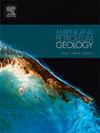潮汐主导的河口沉积系统的古地理重建和沉积演化:厄瓜多尔奥连特盆地钟乳期 M1 砂岩层的启示
IF 3.7
2区 地球科学
Q1 GEOSCIENCES, MULTIDISCIPLINARY
引用次数: 0
摘要
奥连特盆地位于南美洲厄瓜多尔安第斯山脉以东,是一个弧后盆地。有证据表明,在白垩纪时期,该盆地的边缘接受了陆相浅海沉积。由于海岸线附近的容纳和沉积控制因素存在区域性差异,河流-海洋过渡带的沉积环境表现出相当大的变异性。在本研究中,我们分析了 M1 砂岩地层单元(∼83 Ma-72 Ma)的沉积特征,该单元由保存在盆地北部的一组古河口沉积组成。我们量化了混合水动力过程对以潮汐为主的河口地层分布的影响,并讨论了持续横断背景下河口地层的发育条件和演化过程。岩心、测井和地震数据为重建潮汐为主的河口环境提供了证据。在岩心剖面中,我们确定了 14 种岩相和 7 种主要的面相关联类型。与潮汐流相关的沉积结构频繁出现,表明潮汐过程对沉积物进行了广泛的再加工。岩相组合的空间分布趋势揭示了河口地区以潮汐过程为主的混合水动力条件的演变过程,使我们能够将 M1 砂岩层划分为四个沉积期:初始发育期、快速发育期、衰退期和充填后开阔海岸滩涂发育期。此外,通过对水动力条件和沉积物分布的系统分析,我们确定了潮汐主导河口受不同水动力过程影响的多个沉积中心。这些中心分别对应于上游以河水为主的潮汐点障沉积区、中部混合动力沉积相互作用区和下游以潮汐为主的潮汐沙障沉积区。在这些区域,以潮汐沙洲为代表的沙质沉积物大量堆积,反映了潮汐主导型河口的高容纳空间特征。我们的研究结果表明,宽阔缓坡海岸地形的缓慢下沉、稳定的物质运移以及以海洋横断为主的海平面变化,确保了 M1 砂岩层中河口发育所需的容纳空间。对 M1 砂岩层的沉积学研究为了解河流-海洋过渡带的沉积演化提供了一个案例。本文章由计算机程序翻译,如有差异,请以英文原文为准。
Paleogeographic reconstruction and sedimentary evolution of tidal-dominated estuarine depositional systems: Insights from the campanian M1 sandstone formation, Oriente Basin, Ecuador
The Oriente Basin is a back-arc basin located east of the Ecuadorian Andes in South America. Evidence suggests that during the Cretaceous period, the basin's margins received a terrigenous shallow marine sedimentation. Due to regional variations in accommodation and depositional controlling factors near a shoreline, the sedimentary environments in the fluvial-marine transitional zones exhibit considerable variability. In this study, we analyzed the sedimentological characteristics of the M1 Sandstone Formation unit (∼83 Ma-72 Ma), which comprises a set of ancient estuarine deposits preserved in the northern part of the basin. We quantified the impact of mixed hydrodynamic processes on the distribution of tidal-dominated estuarine facies and discussed the development conditions and evolutionary processes of an estuarine formation under the background of persistent transgression. Core, well log, and seismic data provide evidence for reconstructing the tidal-dominated estuarine environment. In the core section, we identified 14 lithofacies and 7 major facies association types. The frequent occurrence of sedimentary structures associated with tidal currents indicates that tidal processes extensively reworked the deposits. The spatial distribution trends of facies associations reveal the evolution of mixed hydrodynamic conditions dominated by tidal processes in the estuary and allow us to divide the M1 Sandstone Formation into four depositional periods: the initial development, rapid development, decline, and the post-infilling open coast tidal flat development periods. Furthermore, through a systematic analysis of hydrodynamic conditions and sediment distributions, we identified multiple depositional centers in the tidal-dominated estuary influenced by different hydrodynamic processes. These correspond to the upstream fluvial-dominated tidal point bar depositional region, the middle mixed-energy depositional interaction zone, and the downstream tidal-dominated tidal sand bar depositional region. In these regions, the substantial accumulation of sandy deposits, represented by tidal sand bars, reflects the high accommodation space characteristic of tidal-dominated estuaries. Our findings indicate that the slow subsidence of a broad and gently sloping coastal topography, stable material transport, and sea level change dominated by marine transgression ensured the necessary accommodation for the development of the estuary in the M1 Sandstone Formation. The sedimentological study of the M1 Sandstone Formation provides a case for understanding the sedimentary evolution in fluvial-marine transitional zones.
求助全文
通过发布文献求助,成功后即可免费获取论文全文。
去求助
来源期刊

Marine and Petroleum Geology
地学-地球科学综合
CiteScore
8.80
自引率
14.30%
发文量
475
审稿时长
63 days
期刊介绍:
Marine and Petroleum Geology is the pre-eminent international forum for the exchange of multidisciplinary concepts, interpretations and techniques for all concerned with marine and petroleum geology in industry, government and academia. Rapid bimonthly publication allows early communications of papers or short communications to the geoscience community.
Marine and Petroleum Geology is essential reading for geologists, geophysicists and explorationists in industry, government and academia working in the following areas: marine geology; basin analysis and evaluation; organic geochemistry; reserve/resource estimation; seismic stratigraphy; thermal models of basic evolution; sedimentary geology; continental margins; geophysical interpretation; structural geology/tectonics; formation evaluation techniques; well logging.
 求助内容:
求助内容: 应助结果提醒方式:
应助结果提醒方式:


